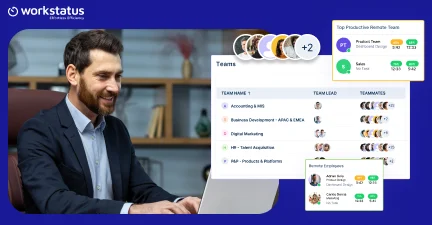Table of Contents
Introduction
We all know that mastering productivity is the key to success.
The Flowtime Technique is a method designed to supercharge efficiency and focus.
According to research, the average worker spends around 2.5 hours handling interruptions daily.
This technique aims to minimize distractions and help individuals enter a deep concentration called “flow.”
Studies show that multitasking can lower the productivity by 37%.
So, adopting the Flowtime Technique could transform how you approach tasks, leading to heightened productivity and better work-life balance.
Understanding The Flowtime Technique
The Flowtime Technique is a strategy to boost productivity by focusing deeply on tasks. It’s based on the concept of “flow,” where you become fully absorbed in what you’re doing, feeling intensely focused and productive.
To start, identify a specific task and set a clear goal for what you want to accomplish.
Then, dedicate a block of time—a Flowtime session—to work solely on that task without interruptions. Concentrating solely on one thing makes you more likely to achieve a state of flow, which can significantly enhance productivity.
This technique encourages deep work, immersing yourself in the task, leading to higher-quality results.
Research indicates that refocusing after an interruption can take about 23 minutes, underscoring the value of uninterrupted, focused work.
The Flowtime Technique isn’t just about completing tasks; it’s about achieving a sense of accomplishment and satisfaction by working with full concentration, ultimately leading to a more productive and fulfilling work experience.
Getting Started With Flowtime
The Flowtime Technique is a powerful approach to turbocharge your productivity by immersing yourself in focused, undisturbed work.
Here’s a detailed guide to kickstart your Flowtime journey:
1. Clear task definition
Identify a task that demands your attention and needs dedicated focus.
It could be a project milestone, writing a report, or completing a specific assignment.
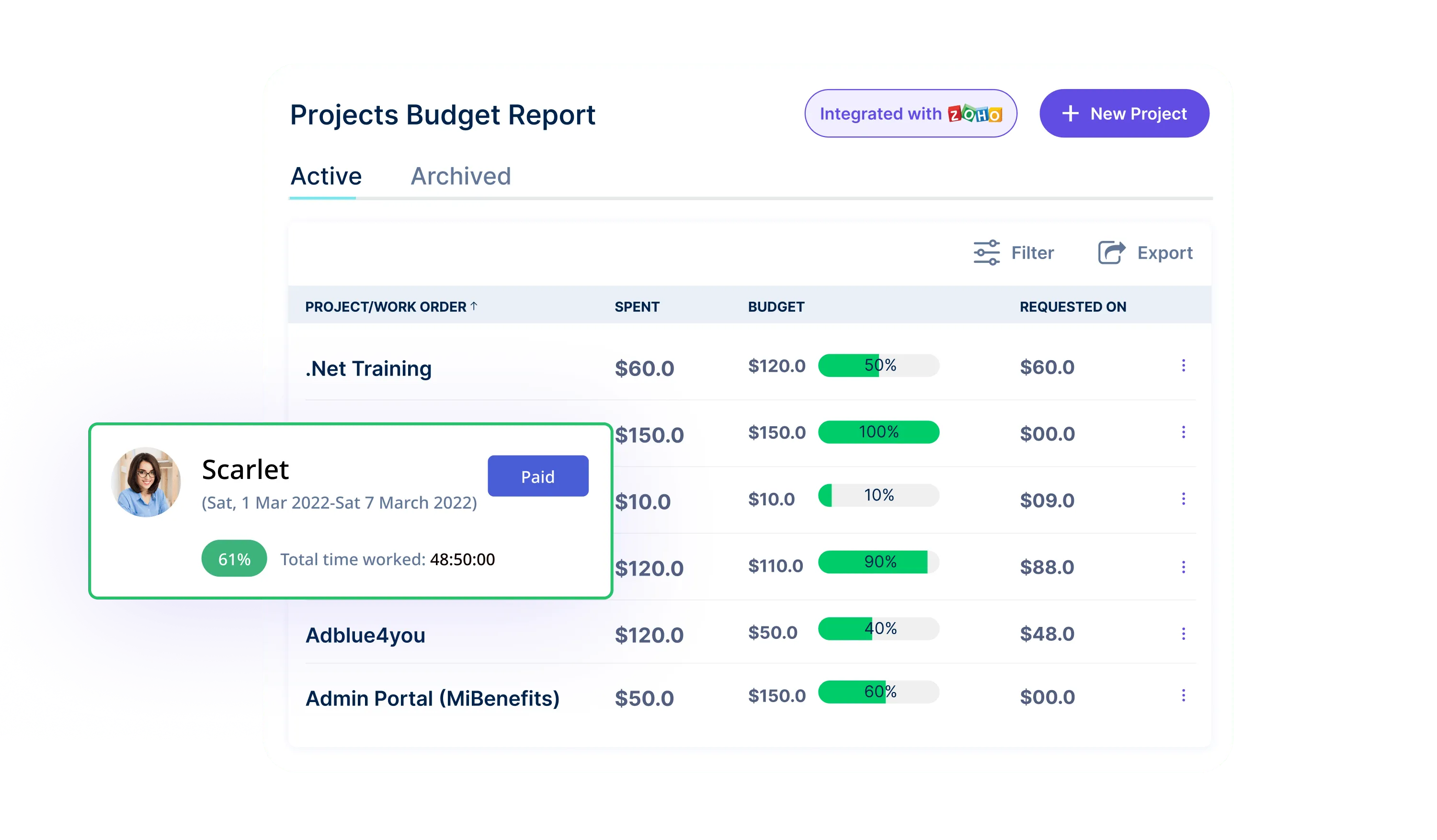
2. Set clear goals
Once you’ve chosen your task, establish clear and achievable goals for what you intend to accomplish during your Flowtime session.
It helps you maintain direction and purpose throughout your focused work.
3. Eliminate distractions
Create an environment conducive to deep concentration.
Find a quiet space, silence unnecessary notifications on your devices, and inform colleagues or family members about your dedicated work time to minimize interruptions.
4. Time block for flowtime
Allocate a set duration for your Flowtime session. Whether you opt for shorter bursts of 25 minutes (known as Pomodoros) or more extended periods, such as an hour or two, select a timeframe that aligns with your task’s complexity and focus capabilities.
Read More:
5. Immerse yourself
Once you begin your Flowtime session, immerse yourself entirely in the chosen task.
Resist the temptation to multitask; pour your undivided attention into this activity.
6. Recharge with breaks
fter each Flowtime session, take short breaks to recharge. Use this time to relax, stretch, or engage in activities that help refresh your mind.
These breaks are crucial for maintaining sustained focus and preventing burnout.
Flowtime isn’t just a technique; it’s a rhythm—a balance between intense concentration and well-deserved breaks.
Experiment with different timeframes and strategies, tailoring the technique to suit your unique work style and preferences.
Start small, embrace the process, and watch your productivity soar!
Flowtime Technique In Action
The Flowtime Technique isn’t just a concept; it’s a practical approach to boosting productivity through focused work sessions.
Here’s how you can put it into action:
1. Setting the stage
- Choose a task or project that requires your attention
- Set specific, achievable goals for this task
- Find a quiet, comfortable workspace free from distractions
2. Starting your flowtime session
- Allocate a dedicated block of time for your task—this is your Flowtime
- Begin the session by immersing yourself completely in the chosen task
- Focus solely on this task without diverting your attention elsewhere
3. Maintaining focus
- Minimize interruptions by silencing notifications and informing others of your focused work time
- Resist the urge to multitask. Concentrate on the task at hand
- Stay engaged and maintain momentum throughout your Flowtime session
Read More: Get More Productive: 7 Golden Rules For Time Management
4. Utilizing breaks effectively
- After completing a Flowtime session, take short breaks to recharge
- Use these breaks to relax, stretch, or do activities that help refresh your mind
- Return to your next Flowtime session feeling rejuvenated and ready to dive back in
5. Adapting and experimenting
- Experiment with different session lengths to find what works best for you
- Assess your productivity and make adjustments to optimize your Flowtime sessions
- Embrace flexibility in your approach to tailor the technique to your workflow
By following these steps and adapting the Flowtime Technique to fit your work style, you can experience heightened focus, increased productivity, and greater accomplishment in your tasks and projects.
Remember, practice makes perfect—so keep refining your Flowtime sessions to maximize their effectiveness!
Also read: Law of diminishing marginal productivity?
Workstatus: Automated Approach To Flowtime Technique
The Flowtime Technique maximizes productivity through focused, uninterrupted work sessions.
Workstatus, with its array of features, offers an automated approach to enhance the implementation of this technique.
1. Time tracking for structured sessions
![]()
Workstatus’s time-tracking feature is a pivotal tool for the Flowtime Technique.
It enables users to designate specific time blocks for concentrated work sessions.
By setting time limits for focused tasks, individuals can immerse themselves in deep work without worrying about time.
2. Activity monitoring to minimize distractions
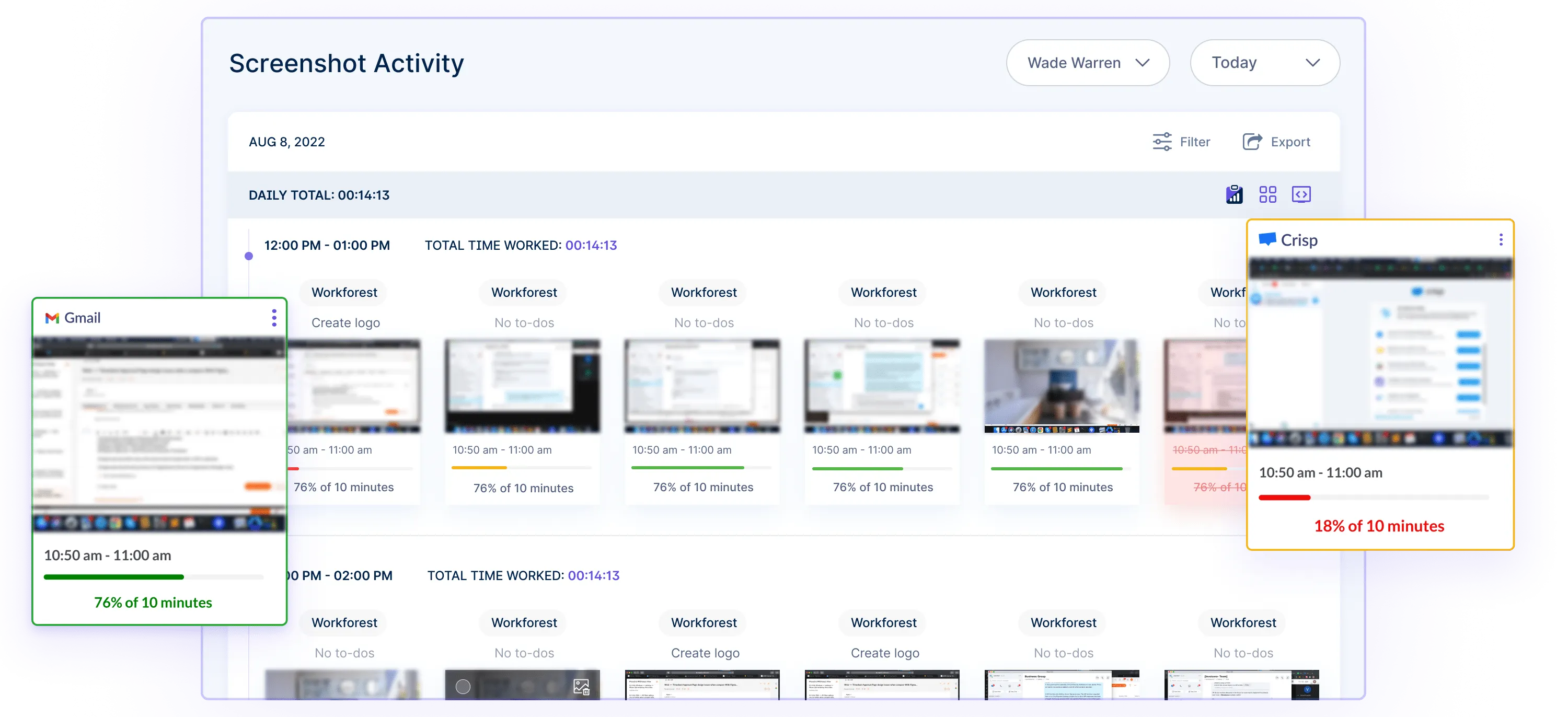
Workstatus’s activity monitoring feature complements the Flowtime Technique by providing insights into work patterns.
It records active work periods, enabling users to identify their most productive hours.
This knowledge aids in scheduling Flowtime sessions during peak productivity periods, reducing distractions, and optimizing focused work.
3. App & URL tracking for distraction management
![]()
The app and URL tracking feature of Workstatus aids in identifying potential distractions.
Users can analyze their digital habits by monitoring the applications and websites used during work hours.
Utilizing this information, individuals can block distracting apps or sites during Flowtime sessions, fostering an environment conducive to deep concentration.
4. Reports and insights for productivity analysis
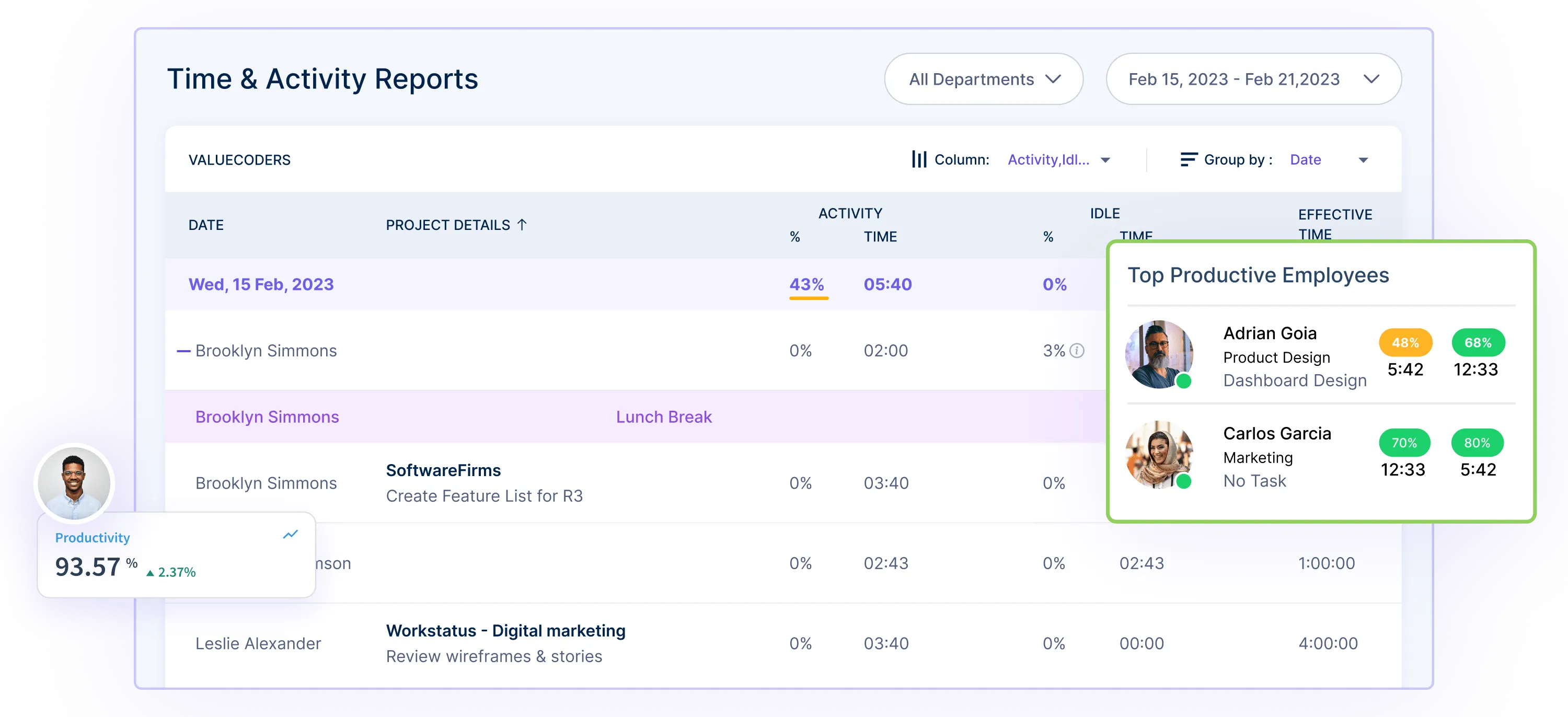
Workstatus’s detailed reports and insights offer a comprehensive overview of productivity trends.
Users can assess their efficiency during Flowtime sessions and make informed decisions to refine their approach.
Analyzing productivity metrics helps fine-tune the Flowtime Technique for better results over time.
Top 6 Benefits Of Flowtime Technique
Here are some significant benefits of the flowtime technique:
1. Better Focus
Flowtime encourages deep concentration on a single task, minimizing distractions and helping individuals become more focused.
By eliminating interruptions and dedicating uninterrupted time to work, individuals can immerse themselves completely in the task at hand, fostering better focus and attention to detail.
2. Increased Productivity
Through focused work sessions, Flowtime boosts productivity levels significantly.
Individuals can complete tasks more efficiently by dedicating specific time blocks to tasks and eliminating multitasking.
This focused approach helps accomplish more within a shorter span of time than fragmented work sessions.
3. Better Quality Work
The Flowtime Technique fosters a ” flow state” where individuals are fully absorbed and engaged in their work.
This intense focus leads to higher-quality output as individuals can effectively channel their skills and expertise into the task, resulting in improved outcomes and creativity.
4. Reduced Stress
Flowtime minimizes stress by reducing distractions and interruptions during work sessions.
Working without constant interruptions creates a calmer and more conducive environment, allowing individuals to focus on tasks without unnecessary pressure and decreasing stress levels.
5. Improved Time Management
Allocating dedicated time blocks for tasks aids in better time management.
Individuals can prioritize tasks more effectively and allocate suitable time frames, ensuring tasks are completed efficiently and deadlines are met.
6. Greater Work Satisfaction
Achieving a state of flow through the Flowtime Technique often leads to a sense of accomplishment and satisfaction.
By fully immersing themselves in the task and producing high-quality work, individuals experience greater fulfillment, making work more enjoyable and rewarding.
The Flowtime Technique offers many benefits, including enhanced focus, increased productivity, better-quality work, reduced stress, improved time management, and greater work satisfaction.
Integrating this approach into daily routines can significantly improve work performance and well-being.
Tips For Successful Flowtime Implementation
Read the infographics below for valuable tips for implementing the flowtime technique.
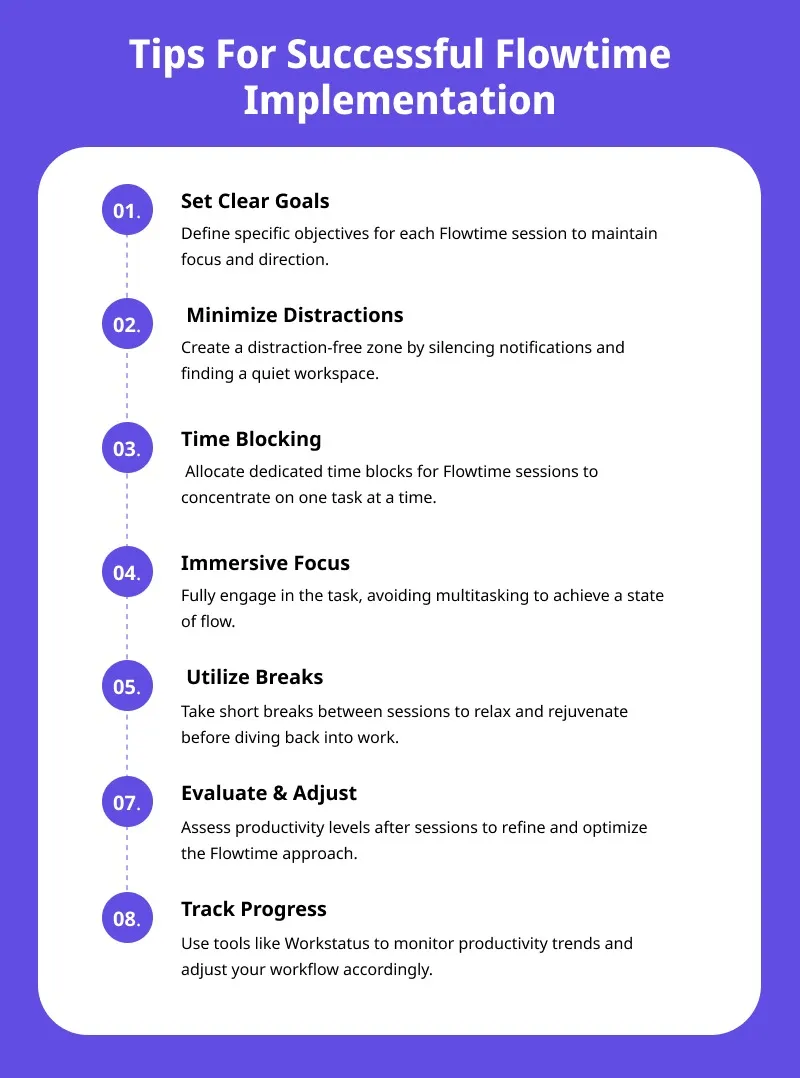
Potential Challenges And Solutions
Now, let’s understand some potential challenges and solutions associated with the flowtime technique.
Challenges:
- Distractions: Facing interruptions from emails, messages, or external noises while trying to focus during Flowtime sessions.
- Maintaining Focus: Difficulty sustaining concentration throughout the entire Flowtime session, leading to a loss of productivity.
- Adapting to Routine: Finding it challenging to adjust to a structured routine for dedicated work periods.
Solutions:
- Distraction Management: Silence notifications, designate a quiet workspace, or use tools like noise-canceling headphones to minimize distractions during Flowtime.
- Techniques for Focus: Employ techniques like the Pomodoro method (25-minute work intervals with short breaks) or mindfulness practices to enhance focus during sessions.
- Gradual Adaptation: Start with shorter Flowtime sessions and gradually increase session lengths as you get accustomed to the routine.
Read More: Turning Boredom InTo Productivity: Tips & Tricks
By acknowledging these potential challenges and implementing practical solutions, individuals can overcome hurdles and make the Flowtime Technique more effective in enhancing focus and productivity during dedicated work sessions.
Measuring Progress And Adjusting
Tracking progress and making adjustments are crucial aspects of making the Flowtime Technique effective.
Keep track of your tasks and accomplishments during Flowtime sessions to measure progress. Use tools like Workstatus to log the tasks completed and the time spent on each.

Review your progress to see if you’ve achieved the goals set for each Flowtime session. Take note of the quality and quantity of work completed during these focused periods. Assess whether you’re experiencing improved focus, increased productivity, and reduced distractions compared to your regular work sessions.
Based on your assessment, consider tweaking your approach. Experiment with different session lengths, alter your workspace setup or try new techniques to enhance your Flowtime experience.
Be open to making changes that align better with your work style and improve productivity.
Refining your approach is an ongoing process. Use the insights gained from measuring progress to refine your Flowtime sessions continually.
Adapt and modify your routine as needed to optimize productivity and focus.
Flexibility is key—embrace changes that positively impact your workflow and discard methods that don’t work well for you.
Flowtime In Various Professions
The Flowtime Technique isn’t limited to a particular job or industry—it’s a versatile approach that professionals from various fields can adopt to improve their work habits.
1. Creative Professions: In fields such as writing, design, or music, Flowtime can help creators immerse themselves deeply in their work. It encourages uninterrupted periods of creativity, allowing individuals to produce high-quality work with enhanced focus.
2. Business and Management: Professionals in managerial roles can benefit from Flowtime by dedicating focused sessions to strategic planning, analyzing data, or making critical decisions. It aids in concentrating on complex tasks without distractions.
3. Healthcare and Medicine: Doctors, nurses, and healthcare providers can utilize Flowtime during patient care, focusing intensely on treatments, diagnoses, or research. It helps maintain concentration during critical procedures or while studying medical cases.
4. Technology and Development: In fields related to software development or programming, Flowtime aids in concentrated coding or problem-solving. It assists tech professionals in achieving a state of deep focus for complex tasks.
5. Education and Teaching: Teachers can employ Flowtime when preparing lesson plans, grading assignments, or conducting research. It allows educators to concentrate on creating engaging and effective teaching materials.
6. Service Industries: From customer service roles to sales positions, professionals can use Flowtime to handle tasks like client interactions, sales strategies, or problem-solving with heightened attention and efficiency.
It helps individuals in diverse fields enhance their productivity, improve focus, and achieve better results by dedicating intense periods of intense concentration to their respective tasks.
Closing Thoughts
The Flowtime Technique is a powerful tool to boost productivity.
You can enhance concentration, achieve higher quality work, and reduce stress by dedicating focused, uninterrupted periods to tasks.
Embracing this method empowers everyone across various professions to maximize productivity, accomplish more, and experience greater satisfaction in their work.




